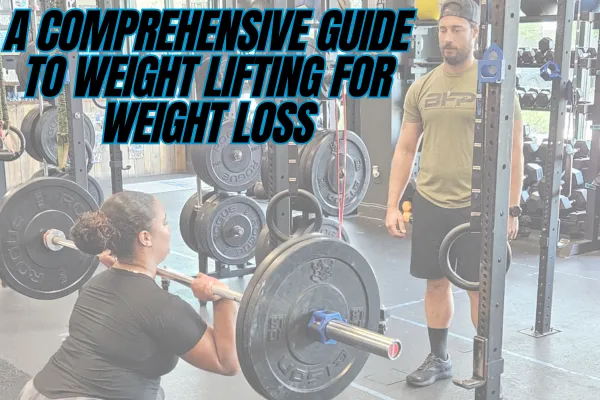WEIGHT LOSS & FITNESS BLOG

A Comprehensive Guide to Weight Lifting for Weight Loss
A Comprehensive Guide to Weight Lifting for Weight Loss
Weight lifting is commonly associated with muscle building and strength enhancement, and currently the Olympics! It's also a highly effective strategy for shedding unwanted pounds. Whether you're just starting out or have been lifting for years, understanding how weight lifting can support your weight loss journey can significantly boost your results.
Why Weight Lifting Aids in Weight Loss
1. Boosts Calorie Burn
Weight lifting elevates your metabolic rate, meaning you continue to burn calories even after your workout ends. This extended calorie-burning period, known as the "afterburn effect" or excess post-exercise oxygen consumption (EPOC), helps you torch more calories long after you've left the gym. You get this from interval training at high intensities but even more so from strength training. The effects add up big over the long haul.
2. Increases Muscle Mass
Muscle tissue burns more calories at rest than fat tissue. By increasing your muscle mass, you elevate your resting metabolic rate (RMR), allowing you to burn more calories throughout the day—even when you're not active.
3. Maintains Muscle During Weight Loss
During weight loss, it's common to lose both fat and muscle. However, incorporating weight lifting into your routine helps preserve muscle mass, ensuring that most of the weight you lose comes from fat.
4. Enhances Body Composition
Lifting weights not only helps reduce body fat but also increases muscle mass, leading to a leaner and more toned appearance. This improvement in body composition gives you a more defined, sculpted look.
Effective Weight Lifting Strategies for Weight Loss
1. Prioritize Compound Exercises
Compound movements like squats, deadlifts, bench presses, and rows engage multiple muscle groups simultaneously. These exercises burn more calories and build muscle more efficiently than isolation exercises, which focus on just one muscle group. Not that isolation exercises don’t have their place, but for weight loss specifically, compound exercises provide more bang for their buck.
2. Lift Heavy Weights
Using heavier weights with fewer repetitions is more effective for building muscle and boosting your metabolism. Aim to lift weights that challenge you and require effort to complete 6-12 reps per set.
3. Incorporate High-Intensity Interval Training (HIIT)
HIIT involves alternating between intense bursts of activity and short recovery periods. Pairing HIIT with weight lifting, such as through circuit training, can maximize calorie burn and improve cardiovascular health. Heart health matters long term as much as strength.
4. Practice Progressive Overload
To continue making progress, gradually increase the weight, frequency, or number of reps in your workouts. This concept of progressive overload prevents plateaus and keeps your metabolism elevated.
5. Prioritize Rest and Recovery
Muscle repair and growth occur during rest, so it's crucial to allow adequate recovery time between sessions. Ensure you're getting enough sleep and downtime to support your weight loss goals.
Nutrition Tips for Weight Loss with Weight Lifting
1. Ensure Adequate Protein Intake
Protein is essential for muscle repair and growth. Aim to consume about 1 gram of protein per pound of body weight daily to support your weight lifting routine and maintain muscle mass.
2. Follow a Balanced Diet
A nutrient-rich diet that includes lean proteins, healthy fats, and complex carbs is vital for energy and recovery. Avoid processed foods and sugary snacks that can derail your progress.
3. Maintain a Calorie Deficit
For weight loss, it's important to consume fewer calories than you burn. Pairing weight lifting with a moderate calorie deficit will help you lose fat while preserving muscle mass.
Debunking Common Weight Lifting Myths
1. Weight Lifting Will Make You Bulky
Gaining substantial muscle mass requires a specific combination of heavy lifting, high-calorie intake, and often a genetic predisposition. For most people, lifting weights results in a leaner, more toned physique rather than bulkiness.
2. Cardio is Superior for Weight Loss
While cardio is beneficial for burning calories and improving heart health, weight lifting is equally, if not more, important for weight loss. It enhances metabolism, protects muscle mass, and improves body composition more effectively than cardio alone.
3. Spot-Reducing Fat is Possible
The idea of targeting fat loss from specific areas through exercise is a myth. Weight lifting helps reduce overall body fat, but where you lose fat first is determined by your genetics and body composition.
Final Tips for Success
- Be Consistent: Stick to a regular weight lifting schedule, aiming for at least 3-4 sessions each week.
- Listen to Your Body: Adjust your workouts and nutrition based on how your body responds.
- Stay Hydrated: Proper hydration is key to muscle function and recovery.
- Seek Professional Guidance: Working with a certified personal trainer can ensure proper form and help you create a personalized workout plan. Book a free intro session by filling out the contact form on this page.
By incorporating weight lifting into your routine, you can effectively lose weight, build muscle, and achieve a stronger, more defined physique. Remember, weight loss is a journey, not a quick fix. Stay patient, stay consistent, and enjoy the process of becoming healthier and stronger.
Stay committed,
Coach Joe


Are you Ready to become
sTRONG - FIT - cONFIDENT?
Click the Button To Start Your Journey Today!!

